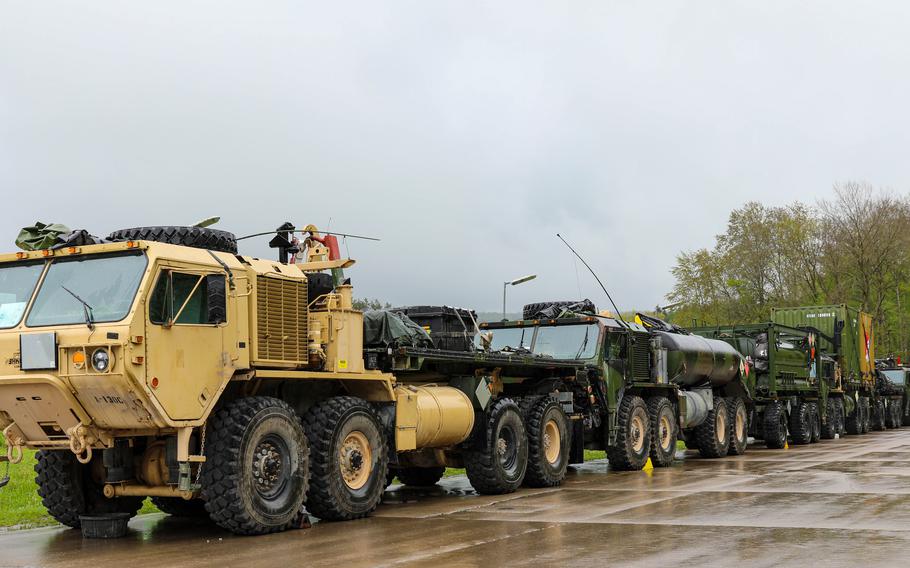BEMOWO PISKIE, Poland (Tribune News Service) — Inside a tank with explosions on all sides, knowing allied soldiers and not enemies are coming up beside you can save lives.
In Poland last week, the 2nd Cavalry Regiment tried out a new system for ensuring that allies from multiple nations all have the same real-time map of the battlefield on their phones and can send chat messages to other soldiers. The regiment drove 2,000 people and hundreds of vehicles from Germany to Poland to participate in the multinational exercise overseen by the 4th Infantry Division, based at Fort Carson.
The new system cuts across international military computer systems and networks to allow soldiers to share sensitive but unclassified information and to bolster safety and effectiveness, 2nd Cavalry Regiment officers said.
"We are able to target the enemy faster and quicker and across allied boundaries. So if I see an enemy, and he's driving over to my ally's area of operations operations, I can then warn him and send him the location of that enemy directly," said Maj. Trevor Senseman, an intelligence officer.
The 2nd Cavalry Regiment was able to try out their system for the first time during a military exercise in northeast Poland that brought together troops from the U.S., Poland, Romania, Croatia and the United Kingdom. The soldiers passed out about 35 phones with applications, called the Green Kit, that run on a secure cloud to troops from all the countries to try. Allies could also use their own devices to join the live map and use potentially many other capabilities, such as live translation, which is the proof of concept stage.
During the training that featured various tanks, ground troops, High Mobility Artillery Rocket Systems, artillery among other firepower from the participating countries, the early tests of the system went well, Senseman said.
"I was able to see all of our partners maneuvering on the battlefield and they're reporting to everybody. … The British were able to turn on their camera on their device, and I was able to view it in the tower. So it's also given us a lot more sensors on the battlefield, too," he said. From the observation tower, Senseman overlooked a wide green practice range that was filled with the sound of gunfire and artillery during the exercise.
Several officers noted the new system is also cheap and scalable, built using off-the-shelf technology. For example, the Army's Tactical Assault Kit application that provides real time mapping of units, is available in a commercial form to law enforcement agencies and fire departments. So members of the 2nd Cavalry Regiment found a way for the commercial version of the application to work with the Army's version to allow soldiers from other nations to get connected, said Senseman and his colleague Maj. Jamie Holm.
Major Ryan Mannina, the regimental operations officer, said he sees lots of opportunities for adoption, including in the Air Force.
"I think we're building momentum very quickly," he said.
A challenge to adoption, he said, could be a mindset shift around the kind of data that can be shared. Some data has been classified because it was shared on a classified system, but it could be shared.
"There's a little bit of a cultural shift that has to happen," he said.
To protect the sensitive information, the system was built for security and flexibility, so the U.S. and allies choose the information they wish to share. For example, Americans could keep their location a secret and just communicate with allies, Senseman said.
If a phone was picked up by an enemy, it would be password protected and if they got into the device, individual users can be removed from the system. Hacking the system would also be tough, because it is secured with the same level of encryption as banking information, Mannina said.
While the 2nd Cavalry Regiment was putting some of these capabilities to the test last week, they were also training to surge into Poland quickly in case of a threat, as the Russian war in Ukraine continues into its second year.
If Americans needed to protect NATO countries in the region, the system could take days off the amount of time it would take for Americans to be coordinate with allies and come up with a communications plan, Holm said.
"We'll come in being able to deliver combat power and integrate with our allies," he said.
(c)2023 The Gazette (Colorado Springs, Colo.)
Visit at www.gazette.com
Distributed by Tribune Content Agency, LLC.

The Vilseck, Germany-based 2nd Cavalry Regiment prepares for exercise Griffin Shock, May 11, 2023. (Gavin K. Ching/U.S. Army)